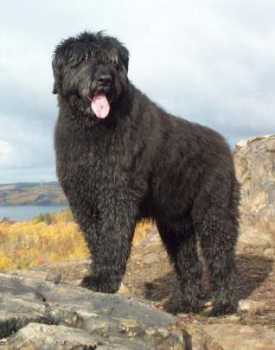In many areas of the world, the large flock-guarding dog was partnered with a small herding dog. In England, after extermination of the wolves, the giant flock guard was not needed, and smaller herding dogs became the norm (an exception being the Old English Sheepdog). But in continental Europe, the demand was for a large herding dog that offered protection for the sheep, as well as controlling the flock. This type has been established since the Middle Ages, probably stemming from Oriental sheep-herding dogs with crosses to local guarding breeds for size and aggression.
In France this combination created the Bri-ard, an old breed told about in legends. Among the many versions of an ancient tale, Aubry of Montdidier was murdered, with the only witness being his dog. The dog followed the killer, haunting his footsteps continually, making the man's life a misery. The king, being made aware of the situation, ordered a duel between the dog and the accused. (Trials by combat, even with animals, were known to occur in the Middle Ages.) The dog avenged his master's death.
Aubry's dog (in French, chien d'Aubry) was a dog of Briard type, and this is a probable source of the breed's name, although it could also be a derivative of the French region of Brie.
Charlemagne gave braces of Briards to friends, and Napoleon so relied on the breed that he took them with him on his military campaigns. Thomas Jefferson added his name to the list of their admirers and imported several dogs to aid the American farmer. Lafayette requested that Briards be sent to him at his American estate.
he Briard is fearless and never timid, hardy and alert and possesses acute hearing. These attributes led the breed to gain a reputation as a noteworthy dog in combat, and to be named the official dog of the French army. The Briard Club of America recounts how these dogs carried supplies to the front lines, served as sentries and found the wounded. Their thick weather-protective coat and sturdiness enabled them to carry machine gun ammunition belts, wrapped around their bodies, to the gunning emplacements. They knew instinctively which soldiers required care and which would not survive. "It was said that any man the Briard passed by was beyond assistance." American soldiers were impressed with the breed, and it wasn't long before the dogs followed the "dogfaces" home.
The Berger de Brie, commonly known as the Briard, and the Berger de Beauce are closely related, with the coat being the major dissimilarity. Both these breeds sport an unusual ear crop, giving them a distinct appearance even today. The ear is shortened and rounded at the tip. The hair on the Briard cascades down off the upright ear, blending into the heavy beard and brows. Both breeds have a "crochet" hook at the end of the tail, which is carried low at rest. The Briard standard, as opposed to those of most breeds, requires the retention of the unusual double rear dewclaws. The best workers were reputed to be those with the extra rear toes, called "bastard fingers" in France.
Personalities are varied: clowns, teases, show-offs, gentlemen, or the "reserved philosophers." Their coarse double coat requires a thorough brushing weekly to remove dead, matting hair and tangles. Their movement is powerful and agile, likened to "quicksilver." They love being outdoors, and some prefer to lie in a snow drift. Briards are protective of their homes, stock and people. Socialization for the young pup is suggested.
Breeds navigation
dog harness and leash
fashion dog harness |

